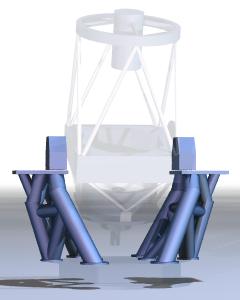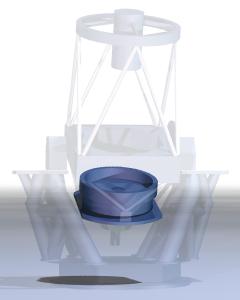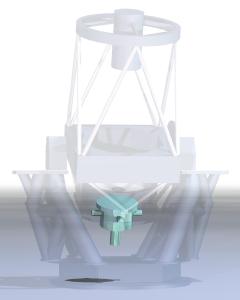Design of the Liverpool Telescope

The Liverpool Telescope
This picture of the Liverpool Telescope (or LT) helps you find out how the different parts of the telescope fit together. A modern reflecting telescope like this is very complicated and needs to be built very carefully.
Click on each part of the telescope to get information about what it does. You can use the links to the left of the picture.

The Base
he base of the telescope acts as a support for the structure. It is home to (azimuth) bearings which let the telescope move from side to side (horizontally). These bearings have two flat metal surfaces that glide across each other on a thin layer of oil. The bearings are very smooth which lets the telescope to follow the stars accurately.
It is very important that the telescope is level when it is working, if not, it won't be able to track the stars and take photographs. The base of the telescope is level to within 20 microns the thickness of a human hair! It is also important that the telescope is mounted concrete, called a pier. This stops vibrations from around the observatory site disturbing the instrument's sensitive measurements.

The Yokes
The yokes provide the second axis of movement for the telescope. They also support the mirrors and instruments.
The telescope moves vertically (up and down) on its altitude axis. The bearings for this movement are at the top of the yoke. These are the same type as those used to move the telescope side to side.
The yoke is specially designed to be as rigid as possible. This is important for when the telescope moves or when it's windy. Vibrations caused by these would limit the quality of the images taken by the telescope. The Liverpool Telescope has been designed to operate in wind speeds of up to 80 km/hour.

The Centre Section
Weighing about 3 tonnes, this part of the telescope is at the top of the yoke. The centre section spins on the altitude bearings to move the telescope up and down. It also acts as the main structure to attach the mirror cell and telescope top through trusses.

The Mirror Cell
The mirror cell is designed to hold the large primary mirror in place as the telescope moves to look at different parts of the night sky. This is not an easy task as the mirror is made from glass and weighs about 1.1 tonnes.
With such a heavy weight the telescope to flex slightly, especially when it moves from a position looking at the horizon to one pointing straight up (zenith).
It is the job of the mirror cell to compensate for these slight movements in the telescope's structure and keep the optics aligned.

The Trusses
The top and bottom of the telescope, where the mirrors are found, are secured to the centre section using steel trusses. These give rigidity and support to the heavy primary mirror at the base of the telescope and the secondary mirror at the top.
It is essential that the two mirrors are kept in line with each other. Imagine the telescope in a horizontal position. The weight of the mirrors, especially the primary mirror, will put stress on the trusses. This can cause a bending effect. To overcome this the trusses form triangles along which the stresses can travel.
A triangle is a very sturdy shape. Bridges and other large structures use triangles to create stability. You can try this out using straws: make a number of structures and then add more straws to make triangles in your structure. You will notice that it becomes stronger and more stable.

The Mirrors
The Liverpool Telescope uses two main mirrors. The first is the primary mirror at the bottom of the telescope. It is 2 metres in diameter and weighs over a tonne. Its purpose is to gather as much light as possible from the stars. The surface is curved so that light is brought to a point or focus. This is where a digital camera is placed, and an image of a small part of the night sky is taken. The primary mirror has to be made to a high specification and is the most expensive part of the telescope.
The other mirror is called the secondary mirror. It is found at the top of the telescope. Its purpose is to bounce the light back towards the primary mirror and focus the instrument to make the images clear. This mirror is also a precision piece of optics which takes a lot of time to make.

The Top Cell
This curved structure forms the top of the telescope. It is held to the main body of the instrument by the top trusses. The secondary mirror is secured to this structure. It has a motor to allow the telescope to focus. This is done by carefully moving the secondary mirror nearer or further away from the primary mirror below. These movements are controlled to within less than the thickness of a human hair while the range of movement can be as much as 5 cm.

The Instruments
The Liverpool Telescope has a professional digital camera to capture images (data) of objects in the night sky. The digital CCD camerasused by astronomers are expensive, but they produce high quality images.
The Liverpool Telescope can have up to 6 instruments for doing different science. As well as the optical camera, there is also an infrared camera, a polarimeter and spectrographs. These allow astronomers to measure distances in the Universe and the chemical composition of stars and other objects.

